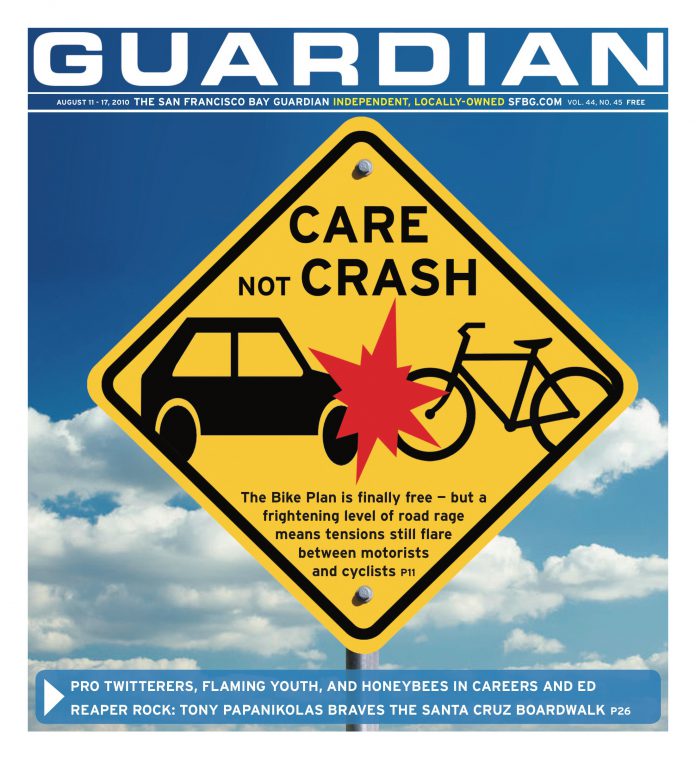arts@sfbg.com
FILM/MUSIC/VISUAL ART Since July 9, local artist David Wilson has programmed the Friday night L@TE shows at the Berkeley Art Museum, in conjunction with “Gatherings,” his installment in the site’s MATRIX series. On Friday the 13th, Wilson concludes his summer contributions to L@TE with presentations by Jamie Stewart, the veritable prince of darkness for Oakland-based indie band Xiu Xiu, and Bay Area film critic Max Goldberg. The program is not only about gatherings in nature but also the assemblage of disparate art forms. Wilson has traversed between media to suss out the kind of aesthetics you can see, and invisible aesthetics that can only be heard. Or as he puts it in an e-mail: “I have been organizing a seasonal series of performances that foster collaborations with different artists and performers and bring people together in unique circumstances.”
Adjacent to Thom Faulder’s BAMscape — a massive orange installation that doubles as sculpture and furniture, beckoning spectators to “sit on it” but also turning them off with its uncomfortable wood seating — Wilson has placed what he calls “a large cove structure of found wood.” It works like an indoor amphitheater. This summer it has become the playing space of musicians such as Grouper and Gamelan Sekar Jaya. Wilson also has framed some works in conjunction with the interactive architecture installed in the gallery. “I’ve been making art about place and experience in place,” he writes. “Often this takes shape as a series of drawings made during explorations through the hills, or as a single drawing of a place.”
When he’s not brooding onstage or exploring childhood trauma in Xiu Xiu, Oakland native Stewart has cultivated a rather self-effacing hobby: bird-watching. “I find myself inexplicably in North Carolina,” he tells me in a phone interview. He’s been living there for about two years. “There are a lot of hunting stores … [with] rows and rows of different animal calls. A lot of these are really horrifying. The hunting bird calls sound like the environment completely exploding.”
I ask Stewart not to be totally forthcoming about his performance, as the element of mystery and the unexpected will be crucial to this event. “It’s an ambient piece,” he says. “I have a really extensive collection of gongs and animal calls and I will be using these together, but with long periods of silence. It’s an attempt to incorporate ideas of 1950s minimalist composition insofar as focusing on the pauses in sound, animal sounds, and a certain amount of physicality.”
In trying to realize the chasm between din and utter silence, Stewart cites composer Rhys Chatham’s Two Gongs (1971) as an inspiration. Of ambient music, Stewart explains, “It ends up being less of a musical experience and more of a psychological and physical experience.”
The aural and physical aspects of Stewart’s contribution — since he will be running from gong to gong — collide with the almost exclusive visual focus of Goldberg’s carefully curated selection of short films, all culled from Canyon Cinema. In the same way that the aural, physical, and visual get cozy and find a crossroads at BAM, the trio of Wilson, Stewart, and Goldberg will gather and treat BAM like a bazaar for the exchange of artistic interests.
Goldberg, a friend of Wilson’s and an admirer of Xiu Xiu (and Guardian contributer), says in an interview that the films he curated are “tuned into different ideas about recording nature. It’s not just observing. You’re in the midst and you encounter it.” For the exhibit, he sought “aesthetically amazing works” because he is “eager to capture the eyes of people who might not know about experimental cinema.”
The six shorts include films by Jeanne Liotta, Len Lye, and avant-garde household name (because there are so many of those!) Stan Brakhage. One of the most stunning works is Ben Russell’s 2007 Black and White Trypps Number Three, which turns a mosh pit into a fugue state with epileptic, chiaroscuro-heavy visuals. “They’re all films with no spoken language, and that was unintended,” Goldberg tells me. He’s curious about BAM-as-theater since it is “not a controlled environment for viewing films.” The projector will be placed right in the audience, in BAMscape’s center.
While Stewart’s performance and Goldberg’s handpicked film selection will not occur at the same time, they will operate in tandem, addressing the aesthetic concerns of place — and its, well, place in nature — while creating a multisensory experience: a disquieting yet provocative full-course feast for the open eyes, ears, and mind.
L@TE: JAMIE STEWART AND FILM PROGRAM BY MAX GOLDBERG
7:30 p.m., $5
Berkeley Art Museum
2625 Durant, Berk.
(510) 642-0808

